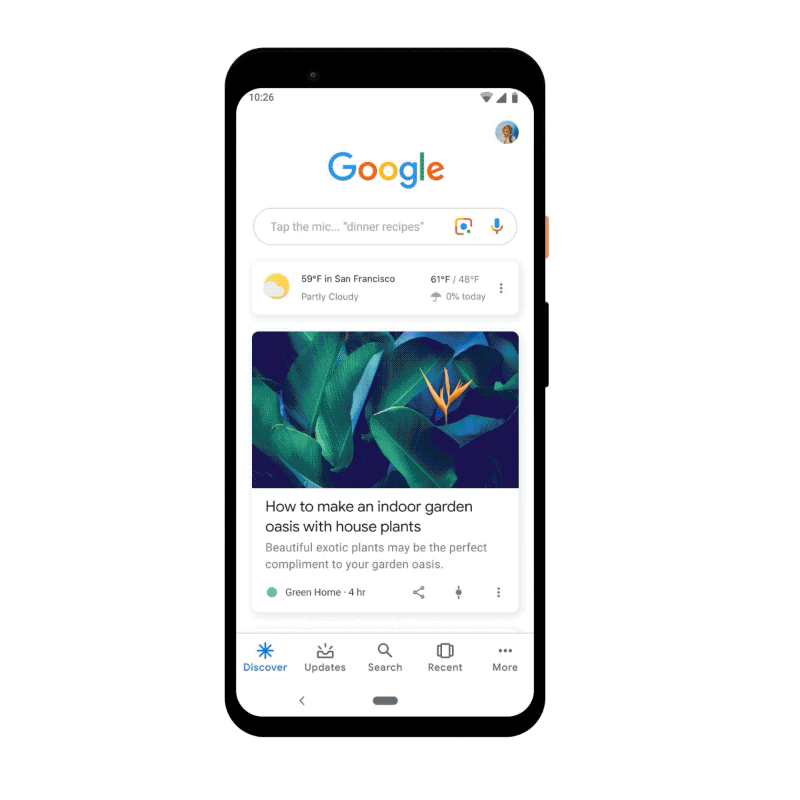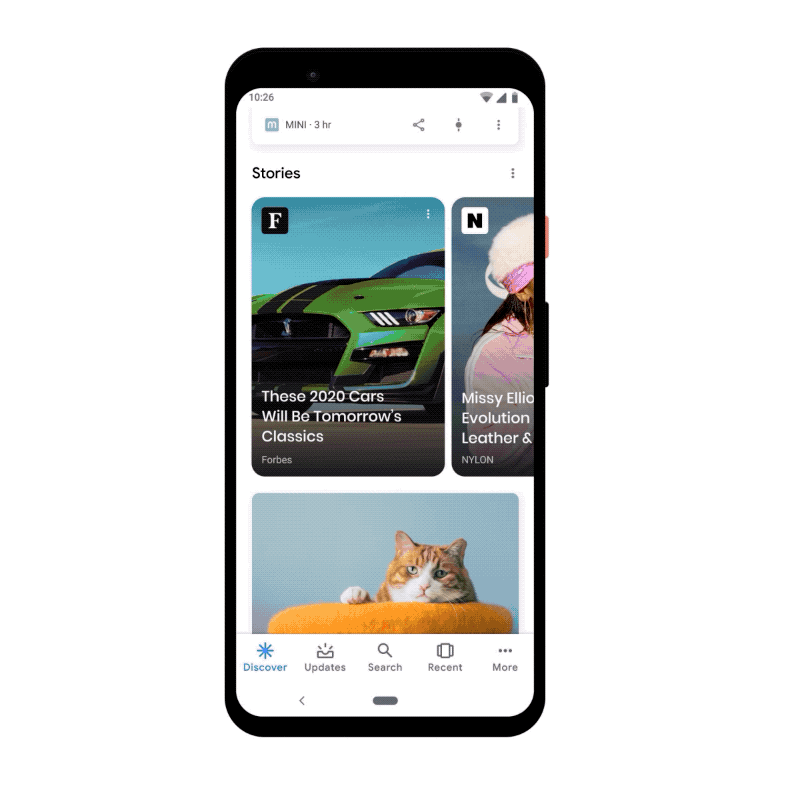Web Stories now have a dedicated space in Google Discover
A new home for Web Stories, the visual and immersive experience on which Google is pushing so much in recent times: in addition to appearing in Serps, in fact, this product now appears in a new and specific carousel featured on Google Discover, in a prominent and highlighted position that can win the attention and clicks of users.
Web Stories are coming on Google Discover
Giving the news is Vamsee Jasti, Web Stories Product Manager, which from the pages of the Google blog describes the operation of this feature, which will help users to find some of the best visual content of the Web directly at the top of Discover, “part of the Google app on Android and iOS and used by over 800 million people every month”.
The carousel of stories is initially only available in the United States, India and Brazil, but Google has already anticipated the intention to expand the functionality in multiple countries and products of its ecosystem.
Browsing through stories is simple: just tap on the preview of one of the stories on the shelf to enter “in an immersive full-screen experience“, and by tapping you can switch to the next page/screen or scroll to read a completely different story in the carousel.
Characteristics and advantages of Web Stories
These content can be made by anyone, single creator or publisher, and already “more than 2,000 sites have published stories that have been indexed by Google,” the article informs. In addition to Discover, stories emerge since 2019 (when they were still called AMP Stories) “in the results of Google Search globally on mobile devices” and will continue to do so with increasing frequency.
The great advantage of Web Stories for creators and publishers is that the product is “entirely under your direction, just like any other content on your website”, which is the big difference between Web Stories and social stories like Instagram and Snapchat. The authors of the stories have “full control over monetization, hosting, sharing and adding links to their stories”.
Publishers can also share stories with a URL, just like you do with any other web page, and allow you to view them outside of the Google app. Being in practice an extension of the site, “some of the first Web Stories users show their stories on their home page, social channels, newsletters and more”, thus drawing further traffic.
Creating Web Stories is easy
You can encode stories from scratch if you have the right technical skills, but to increase their adoption Google has released user-friendly tools that assist publishers: this is the case with the Web Stories plugin for WordPress, a drag-and-drop editor that allows you to create a story starting from default templates to which to add your own content, or other tools such as MakeStories and NewsroomAI, which in a few minutes allow you to complete a story to be added on the site.
In addition, Google has published a page dedicated to the content policy of Web Stories, which contains useful information that must be followed by all those who are interested in producing this content and all uses on Google products.
Google’s regulations for Web Stories
To appear both on Google Discover and in the Search as individual results, the stories must first comply with the Google Discover rules and the Instructions for Google webmasters. In order to emerge on richer experiences on Google (for example, grid display in Search, Google Images and the new carousel on Google Discover), web stories must comply with more specific rules relating to additional content and, in case of serious violations, a site “could stop appearing permanently in the richest experiences on Google”.
In particular:
- Copyrighted Content. Google does not accept stories “that violate anyone’s copyright”. Web Stories are intended to “reflect original works, so we do not allow content that includes someone else’s copyrighted work, unless you have received permission”.
- Web stories with too much text (Text-heavy). Web Stories are a fast snack format, so excessive use of text is not allowed: if most pages contain more than 180 words, stories may not be eligible. Where possible, the use of small videos (less than 60 seconds per page) is encouraged.
- Resources of low quality. Google does not accept web stories that contain deformed or pixelated images and video resources to the point of negatively affecting the viewer’s experience.
- Lack of narrative. No stories are accepted “without a binding theme or a narrative structure from page to page”.
- Incomplete stories. You are not allowed “incomplete web stories or requiring users to click links to other websites or apps to get essential information”.
- Too commercial. Google does not accept “Web Stories where the only objective is to advertise a service or a product, especially if you can benefit directly from users who consume your Web Story”. Affiliate marketing links are allowed “provided they are limited to a minor part of the Web Story”, while display ads “can be placed following the Story Ads Guidelines”.
Best practices to create effective Web Stories
Another page of Google guides instead explains what are the best practices recommended to achieve successful Web Stories. Among the suggested actions are:
- Use videos, which are more engaging than text or images (that can still complete the content).
- Do not create pages full of text (the so-called walls of text) and try to reduce the text to about 280 characters per page (the length of a tweet).
- The text must not be blocked by other contents on the page.
- All text must be visible to the reader and kept within limits. Avoid burning in the text, so as to prevent it from being locked when it is resized to fit various device sizes.
- Using animations can create involvement, but it is best to avoid annoying or repetitive animations that can cause fatigue.
There are also SEO actions that you can perform for Web Stories:
- Like any web page, providing high-quality content that is useful and interesting for readers is the most important thing: you have to include a complete narrative and follow the best storytelling practices to keep readers engaged.
- Titles must be shorter than 90 characters (preferably below 70) and descriptive.
- Do not include a noindex attribute in the story and add web stories to the sitemap.
- The HTML canonical tag must be at least the same domain as the URL. The pairing link rel= “amphtml” is not available for Web Stories. A long form article (or standalone video) and a Web Story on the same topic “are different autonomous web experiences” and one of the experiences should not be canonical for the other. However, if there is a separate web page with the same content as a Web Story, you may consider making the Web Story canonical.
- Stories should follow the AMP story metadata guidelines, including markups normally included on a web page, such as:
- meta tags title and description
- Structured data
- OGP
- Twitter card
In the end, there are technical recommendations:
- Web Stories must be AMP pages
- Keeping the poster image text free, because “this could obstruct the title of the story when users preview it in search results. If users are not able to clearly read the title, they may be less likely to continue reading“.
- The image linked to <amp-story> poster-portrait-src attribute must be at least 640 x 853 px and use a 3:4 aspect ratio.
- The logo image attached to <amp-story> publisher-logo-src attribute must be at least 96 x 96 px with 1:1 proportions.
Cover image from: https://stories.google/




